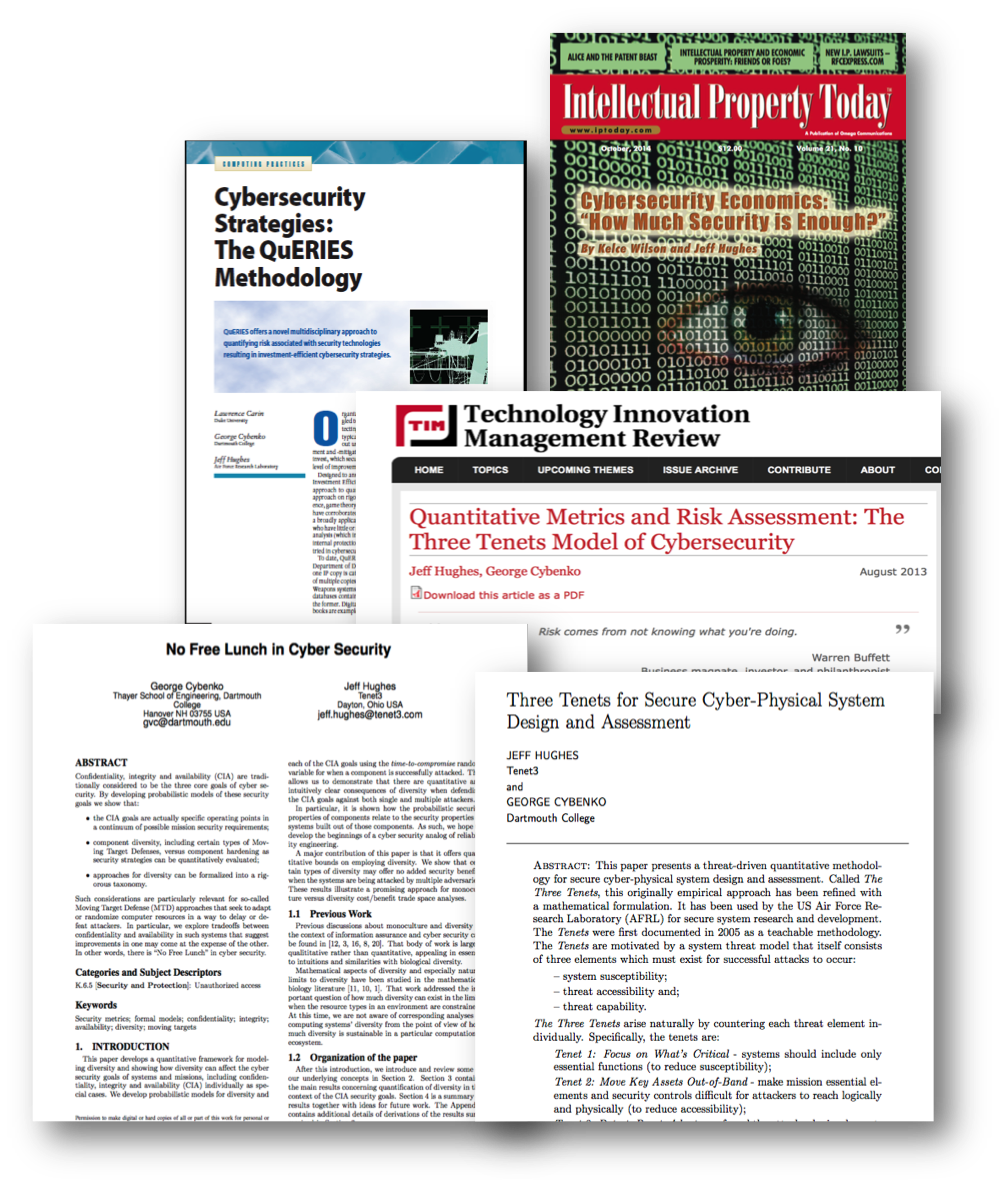Zero Trust Strategy Requires Planning
Cyberspace is an adversarial domain. Securing cyberspace is hard
because systems are complex and built with components from across the globe.
Most cyber-physical systems are constructed using commercial
parts where time-to-market is the measure
of success, not security. This results in the hope that other peoples’ work
is inherently correct and secure from adversary influence.
Hope is not a strategy.
Our approach to cyber strategy is grounded by our foundational work in anti-tamper,
software protection, and trustworthy hardware. Tenet3 personnel were developing
quantitative "Zero Trust" strategies in the late 1990s before Zero Trust was cool.
Strategy is Born of Planning
In preparing for battle I have always found that plans are useless but planning is indispensable.
- Dwight D. Eisenhower
Zero Trust fundamentally requires planning. Start by taking stock. Enumerate the software and hardware components
in your systems and facilities. Organize things by what is critical. Identify how your people
interact with the elements of your systems and company processes.
Show how everything is connected or related to your mission.
We call this planning process
Count-Collect-Connect® and the result is a digital system map or knowledgebase
(a Model Based System Engineering database) for your systems,
networks, or organization.
A Zero Trust Planning Axiom - The System Defines Its Own Threat
Murphy was right. Edward A. Murphy, Jr. was an engineer with the US Air Force
and spent time at Wright-Patterson Air Force Base. He was said to state
"Anything that can go wrong will go wrong".
This is especially true in cyber-physical systems today. All systems have
access points, weaknesses, and ways to connect the two.
The system knowledgebase developed in the Count-Collect-Connect® step
is used with this planning axiom to assess possible threat actions and the likelihood of adversary induced failures.
Cybersecurity is a study of failure modes in a system and how best to mitigate them.
Tenet3 personnel learned this well when leading anti-tamper programs for the Department of Defense.
Using a property graph knowledgebase, we automate the computations of Zero Trust metrics over system
models. Quantitative cyber
risk mitigation strategies are developed based on these computed metrics.
Cyber Resilience - From Art to Craft to Science
Art requires innate talent. A craft is a teachable skill. A science is predictive, quantitative, and testable.
- Our long time collaborator and friend, Prof. George Cybenko, Dartmouth College.
Mindful of this, Tenet3 is developing the science of cybersecurity. We bring together expertise in reverse engineering, anti-tamper techniques,
AI/ML driven property graph modeling, cloud scale data science, and game theory to formulate a scientific framework. Elements of our framework are
described in our publications.
We quantitatively assess risk by constructing "digital thread models"
of systems across multiple levels of detail and throughout the system lifecycle.
Our digital thread models are key to our System Security Engineering analytics that reveal
the cyber security trade space. We model both physical and logical systems and processes.
Our digital threads range in detail from hundreds of millions of transistors, to firmware/software models,
to models of boards and units connected via networks and buses. Tenet3 digital threads model
systems "as designed", "as built", and "as operating".
Tenet3 solutions can ingest supply chain and
design documents to create system models or construct them via highly sophisticated "tear downs"
of existing systems. Tenet3 technologies include: rapid system data ingestion and curation
using our data crawling agents, data lake, and patent pending blockchain technology; highly
scalable and rapid system modeling via property graphs; AI/ML graph driven data analytics;
and game theoretic analyses of adversary versus defender cost drivers. These core competencies
support vulnerability analyses, quantitative system risk assessments for enlightened mission
planning and operation, efficient continuous monitoring for system diagnostics,
complete system penetration testing, and cyber security economics evaluation.
Our approach to Zero Trust is based on seminal work in DoD Anti-Tamper and cyber-physical system security.
Model based system engineering (MBSE) models are an essential authoritative source of truth for subject matter experts and system
stakeholders alike. Construction of MBSE "Cyber Twins" begins with hardware and software component enumeration.
Data about the system or components is collected from disparate souces. This data is organized
and curated into information. Information is transformed into knowledge graphs. Our MBSE solution, MeTRA®
manages this Count-Collect-Connect® process and databases these models as essential digital engineering system baselines.
MeTRA® Curate is our AI/ML based information gathering and curation engine. When construct system models by enumeration of
components and associated data. Curate includes: our patent pending blockchain based data ingestion software and data lake;
our NLP based automated entity/relation builder for parsing system documents and building system model primitives;
and our computer vision based automated system diagram to property graph generator.
MeTRA® Model is our flagship software (most often just called MeTRA® - Measured Threat Risk
Assessment). MeTRA® provides a web-based modeling framework and analysis tool suite that delivers
visual and interactive complex system knowledge capture, management, analysis and transfer.
The intuitive software guides security, engineering, and program management personnel through a
methodical decomposition of the system using standard program documentation and Tenet3’s
Count-Collect-Connect® methodology. This provides a “Digital Thread” for systems - as designed - as built - as operating.
These highly scalable property graph system representations model systems from transistor level designs, software, and circuit boards, through
weapon systems and factories. MeTRA® supports quantifiable metrics that inform system security assessments.
MeTRA® Assess is a collection of web browser dashboards that operate on the property graph models
above to compute attack paths, vulnerabilities, and defensive mitigations via calculations of adversary
versus defender work factor. This includes our RMF & CMMC based security compliance tools. Assess
utilizes simulations based on various mathematical, statistical, optimization, game theoretic, and
property graph theoretic analyses implemented at cloud scale.
Supply Chain Tools include Tenet3’s SAFELib™ and MeTRA® Discover tools to examine risk in software and hardware components.
SAFELib™ technology enables seamless and fast code assessment in a CI/CD pipeline without
any of the weaknesses of static analysis solutions. The capability hinges on a trained deep learning model
(neural network) designed to evaluate, at the function level, whether a block of committed code exhibits patterns
that are indicative of one of many vulnerability types.
MeTRA® Discover is our highly scalable sub-graph matching implementation which permits us to search
large property graphs for specified subgraph structures. This capability enables us to search advanced
microelectronic circuits for unwanted components.








